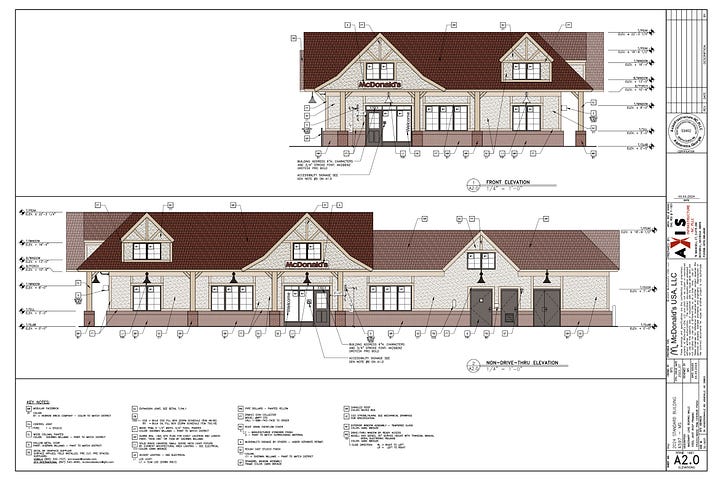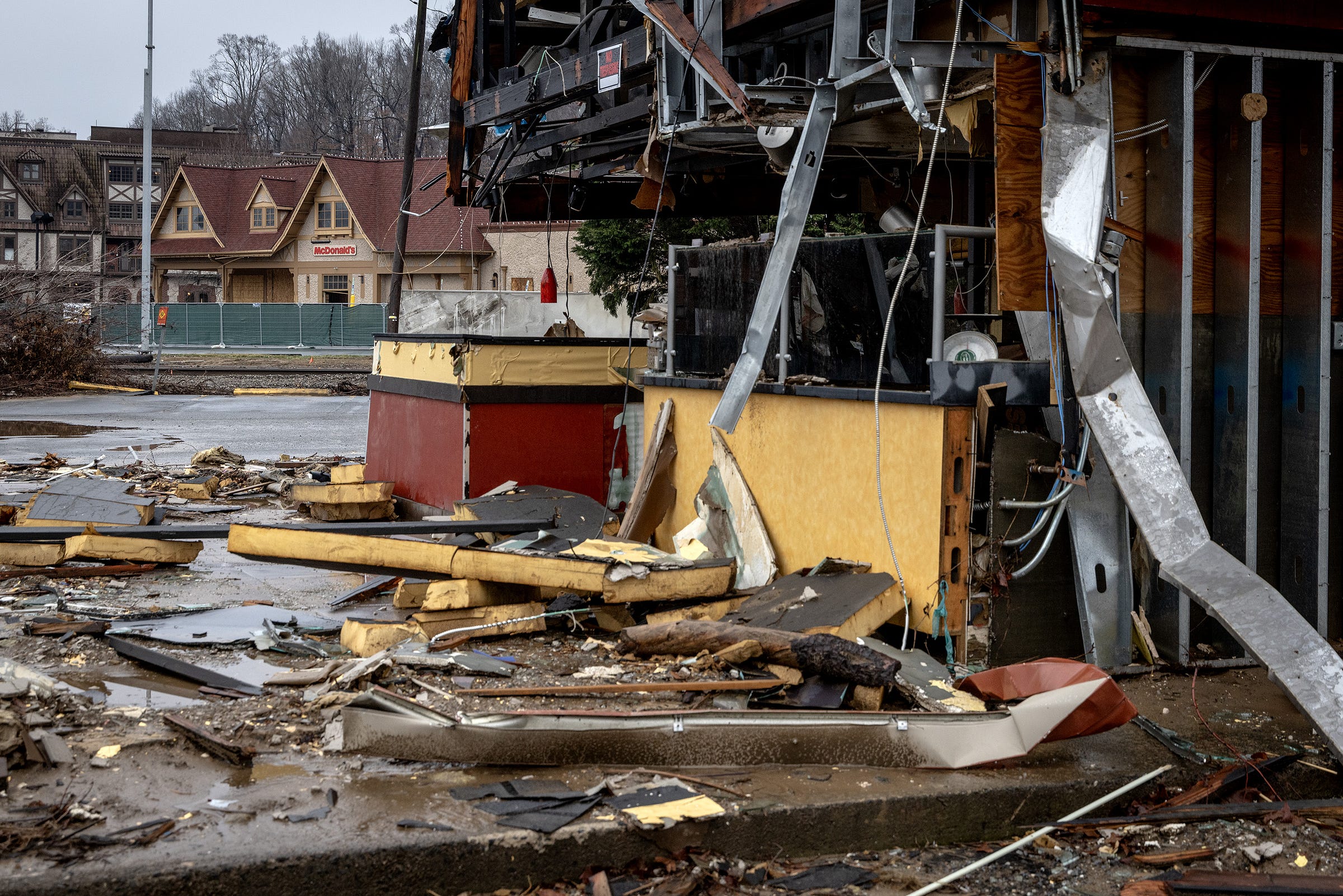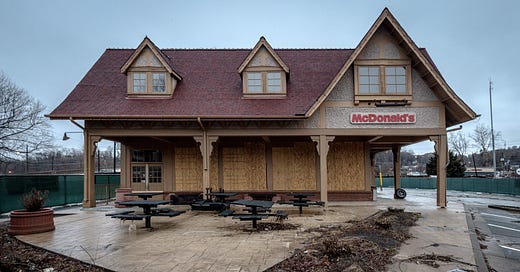Landmark McDonald’s Destroyed by Tropical Storm Will Rise Again
Biltmore Village restaurant is the first major rebuilding project since Helene devastated the region
ASHEVILLE, N.C.—One of the most iconic McDonald’s in the United States was heavily damaged by Tropical Storm Helene. On Wednesday, the demolition and redevelopment of the restaurant became the first major project in the area to be approved by Asheville’s Historic Resources Commission since the disaster devastated the region.
The McDonald's located at 35 Hendersonville Road in Asheville, North Carolina sits at the entryway to the famous Biltmore Estate, the largest privately owned home in the United States and a tourist destination that sees 1.4 million visitors a year. The restaurant itself, with a half-timbered cottage design that fits in among the surrounding buildings and a self-playing grand piano that filled the dining room with music throughout the day, was perhaps just as much of a draw.
The restaurant had previously weathered tropical storms before succumbing to flooding caused by Helene in September 2024. Much of the region remains in a state of disrepair over four months later: storefronts are boarded up, fallen trees line the highways, and detritus is piled up in the streets and waterways. Asheville was the first trip made by President Trump after his second inauguration to meet with local leaders and survey residual damage from the storm.
Though the Biltmore Village McDonald’s has now been approved for demolition and rebuilding, it was not without some jostling over localization and nostalgia.

Rebuilding a landmark
Flood waters from Tropical Storm Helene reached over ten feet high inside the Biltmore Village McDonald’s, destroying the kitchen, rearranging the furniture, and moving the baby grand piano through the windows and into the parking lot. Raising the elevation of the flood-prone lot would future-proof the restaurant to some extent, but would require the demolition and redevelopment of the building.
At a January hearing of the Historic Resources Commission in Asheville’s City Hall, the plans were reviewed, and staff member Alex Cole noted that the McDonald’s was “the first major work in Biltmore Village since the storm.” The commissioners presented a laundry list of gripes with the new design, but mostly complained that the building seemed too modern and wanted it to be more “cottage-like”, sending the McDonald’s team off to revise the plans.


This past Wednesday, the new plans were presented. Numerous modifications were made, most notably the shape and location of the dormer roofs, and the style of the windows. Yet, several commissioners remained unsatisfied, as the proposed structure clocked in at 22 feet, versus the current one at over 30 feet.
“Is there a reason why they’re just not rebuilding what they had?” asked commissioner Leslie Humphrey. When told that it was a matter of “dollars talk,” Humphrey remarked, “It’s McDonald’s, they make tons of money! And this is the most important McDonald’s in the country, isn’t it?”
During the public comment period, members of the local community spoke on the need to get the ball rolling on rebuilding the area. “I would encourage you to look favorably upon this application,” said Benjamin Mitchell, Chairman of the Biltmore Village Merchants Association. “This would be a very strong message to the world that people are still optimistic in this community and invested in making the community better.”
Ultimately, the commission decided that although it was difficult to “unsee” what was already there for over two decades, the plans met the standards set forth in the Biltmore Village Development Plan, and issued a Certificate of Appropriateness. Speaking with this reporter after the meeting, representatives from McDonald’s indicated that although they’d love to bulldoze the building and put up a new one “tomorrow”, there were still a litany of approvals involved. They estimated that the store would reopen in under a year.
As for the baby grand piano—I’m told that there are already multiple avenues for securing one in time for the opening.
Localizing the arches
Communities with architecturally localized McDonald’s in the United States had their way paved in the 1980s, when pushback from residents of Freeport, Maine forced McDonald’s to purchase and move into Gore House, a local merchant’s home, instead of building one of their then-standard Mansard structures. Denton House in New Hyde Park, NY. followed suit a few years later, as town after town in Long Island started getting McDonald’s restaurants that more resembled single-family homes than fast food joints.
The Biltmore Village McDonald’s has been a fixture of the area since 1971, though its stock design and oversized signage was a point of ire for the community. But with the 1988 release of the Biltmore Village Historic Village Design Guidelines and the 1992 ratification of the Biltmore Village Development plan, buildings in the area now had to adhere to an English cottage-style half-timbered aesthetic. The pressure was on for the Golden Arches to better fit into the area.
So in 2001, the McDonald’s was rebuilt. Designed by Asheville-based architect Robert Griffin, who helped steer Biltmore Village’s development plan, the new restaurant was opened with an event attended by the Asheville Chamber of Commerce and wine provided by the Biltmore Estate. Inside the restaurant, the aforementioned baby grand piano churned out tunes throughout the day, the staff wore trousers and bow ties, and over time the location became known as one of the world’s “fanciest McDonald’s”.
It is unlikely that the new Biltmore Village McDonald’s, whenever it is completed, will earn the title of fanciest. But the restaurant has, perhaps, a bigger purpose: the first major step toward rebuilding a community after a disaster.





